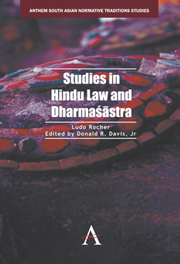Book contents
- Frontmatter
- Contents
- Foreword by Richard W. Lariviere
- Preface
- Abbreviations
- Note on the Edition
- Introduction
- PART ONE THE NATURE OF HINDU LAW
- PART TWO GENERAL TOPICS OF HINDU LAW
- PART THREE HINDU LEGAL PROCEDURE
- The Theory of Proof in Ancient Hindu Law
- The Problem of the Mixed Reply in Ancient Hindu Law
- The Reply in Hindu Legal Procedure: Mitra Miśra's Criticism of the Vyavahāra-Cintāmaṇi
- “Lawyers” in Classical Hindu Law
- Anumāna in the Bṛhaspatismṛti
- PART FOUR TECHNICAL STUDIES OF HINDU LAW
- PART FIVE ANGLO-HINDU AND CUSTOMARY LAW
- Bibliography
- Index
The Problem of the Mixed Reply in Ancient Hindu Law
from PART THREE - HINDU LEGAL PROCEDURE
Published online by Cambridge University Press: 05 February 2013
- Frontmatter
- Contents
- Foreword by Richard W. Lariviere
- Preface
- Abbreviations
- Note on the Edition
- Introduction
- PART ONE THE NATURE OF HINDU LAW
- PART TWO GENERAL TOPICS OF HINDU LAW
- PART THREE HINDU LEGAL PROCEDURE
- The Theory of Proof in Ancient Hindu Law
- The Problem of the Mixed Reply in Ancient Hindu Law
- The Reply in Hindu Legal Procedure: Mitra Miśra's Criticism of the Vyavahāra-Cintāmaṇi
- “Lawyers” in Classical Hindu Law
- Anumāna in the Bṛhaspatismṛti
- PART FOUR TECHNICAL STUDIES OF HINDU LAW
- PART FIVE ANGLO-HINDU AND CUSTOMARY LAW
- Bibliography
- Index
Summary
The Fourfold Subdivision of the Reply
It is a well known fact, that in all sources dealing with ancient Hindu adjective law four different types of legal reply have been neatly distinguished (Kane 1930–62: 3.300–301). This fourfold subdivision of the reply might perhaps even be said to be one of the more stable and constant factors among the endless series of enumerations and subdivisions to be found in the ancient Indian law books.
Inasmuch as a clear insight into the said four types of reply will prove necessary in order to fully appreciate the intricacies called forth by the mixed reply, at first the main types of reply shall be briefly defined and illustrated here.
In the first place, confession (satya, saṃpratipatti) is the statement in which the defendant acknowledges the truth of the facts mentioned in the plaint (Vyāsa 1.24).
Secondly, at least as far as the age of the Dharmaśāstras is concerned, a reply is said to be a reply by way of denial (mithyā, mithyottara) when the defendant contradicts the facts referred to in the plaint (KS 167).
Later on, at the time when Dharmaśātra literature —and all other branches of learning as well— becomes deeply influenced by the concepts of Indian logic (Nyāya) a much more subtle definition comes to the fore.
- Type
- Chapter
- Information
- Studies in Hindu Law and Dharmasastra , pp. 395 - 404Publisher: Anthem PressPrint publication year: 2012



